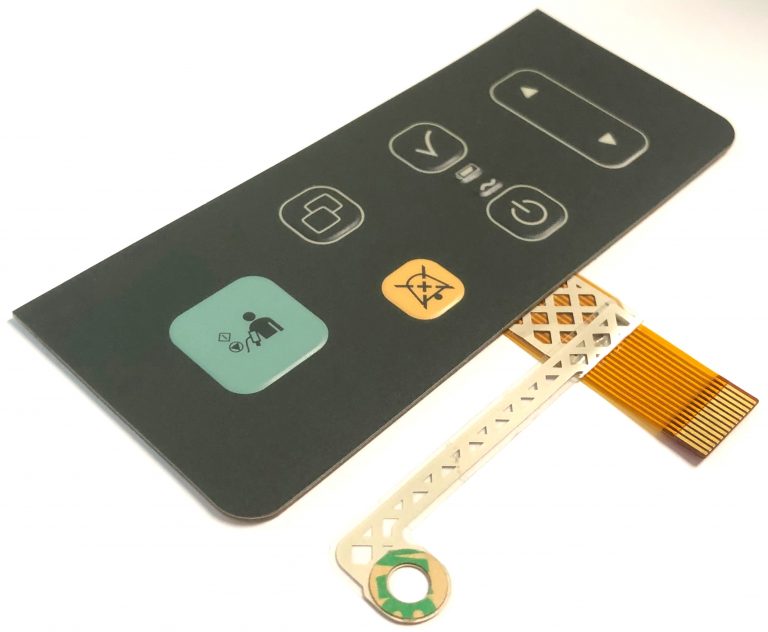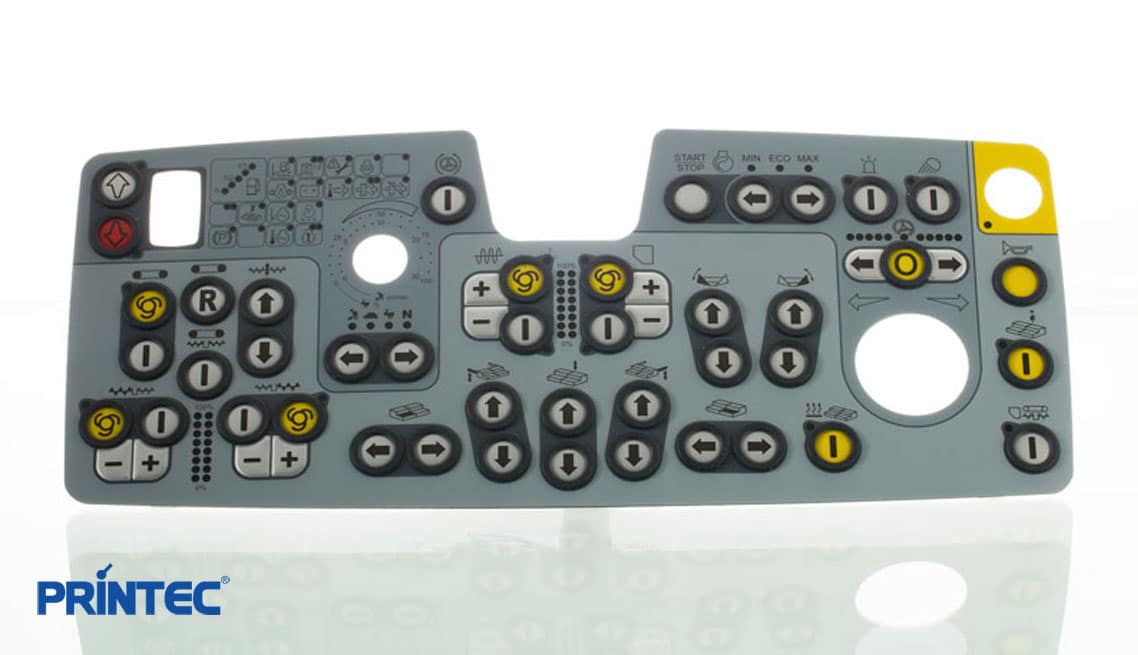Everything About Membrane Layer Switch: Understanding Its Layout and Capability
When you think concerning the control interfaces in modern devices, membrane buttons frequently come to mind. Allow's explore what collections membrane changes apart from various other control systems.
What Are Membrane Buttons?

Their seamless nature makes them easy to tidy and immune to dust and moisture, a crucial attribute in many atmospheres. Membrane buttons can also be personalized relating to shape, dimension, and graphics, permitting suppliers to develop one-of-a-kind user interfaces tailored to specific items. And also, they're light-weight and slim, which helps in minimizing the total bulk of devices. In general, membrane switches play a substantial function in improving individual experience throughout a broad variety of applications.
How Membrane Layer Changes Work
When you press a trick on a membrane layer button, it triggers a simple yet reliable device. The top layer, typically made of adaptable material, pushes down onto a conductive layer under it. This action bridges the void between conductive traces, finishing an electric circuit. As soon as the circuit shuts, it sends a signal to the gadget's controller, which translates your input.
You'll observe that the responsive feedback differs based upon the switch style, offering either a soft click or a much more obvious reaction. Once you launch the trick, the membrane returns to its original placement, reopening the circuit and stopping the signal. This procedure takes place almost immediately, making sure a receptive customer experience.
Membrane switches are prominent as a result of their longevity and resistance to dirt and wetness, making them optimal for numerous applications, from household home appliances to clinical tools. Understanding this operation helps you value their prevalent usage.
Trick Parts of Membrane Switches
Recognizing the vital parts of membrane layer switches is essential for grasping their capability and style. At the core, you'll locate the visuals overlay, which offers the aesthetic interface for users. Below that, there's a spacer layer that separates the circuit layers, guaranteeing that they don't make contact up until pressed. The circuit layer is where the magic happens; it includes conductive traces that complete the circuit when you press the button. Another crucial element is the sticky backing, enabling the switch to abide by surface areas firmly. Ultimately, the safety layer guards against environmental variables and put on, extending the button's life-span. Each component plays a significant role in ensuring reputable performance and individual interaction. By understanding these elements, you'll acquire understanding right into exactly how membrane layer switches over run and their relevance in different applications.
Materials Utilized in Membrane Layer Switch Over Design
The efficiency and sturdiness of membrane switches over greatly depend on the materials used in their design. You generally run into polyester and polycarbonate as primary substrates because of their outstanding toughness and versatility. These materials stand up to scrapes and chemicals, making them optimal for demanding environments.
The conductive layers commonly utilize silver or carbon, selected for their reliability and conductivity. membrane switch manufacturer. Silver provides exceptional efficiency, while carbon is a cost-efficient alternative. For the overlay, you may consider a matte or shiny coating, depending on your aesthetic requirements and customer experience
Make certain to select adhesives that endure ecological aspects like temperature and humidity. Selecting the ideal materials will assure your membrane layer button stands the examination of time.
Style Considerations for Membrane Switches
While creating membrane buttons, it's crucial to take into account various variables that affect their functionality and customer experience. Begin by focusing on the layout and switch size; make specific they're intuitive and easy to browse.
Do not neglect the visuals design; clear labeling and shade comparison are significant for presence. Confirm your layout fits environmental aspects, like dampness or temperature variants, which might influence efficiency. Finally, remember the significance of screening prototypes with real users to gather responses and make required modifications. This repetitive procedure helps you refine the design, verifying it fulfills both functional and visual needs properly. By carefully taking into consideration these aspects, you'll create a membrane layer button that improves use and contentment.
Applications of Membrane Buttons
Membrane layer buttons are functional elements found in various applications, from industrial tools to customer electronic devices. You'll see their impact browse around here in devices that require sturdy user interfaces and in tools that profit from streamlined layouts. Recognizing these applications assists you appreciate the capability and functionality of membrane switches in everyday modern technology.
Industrial Tools Use
When you're seeking to improve the functionality of industrial devices, membrane buttons provide a reputable option that incorporates toughness with straightforward style. see it here These switches are ideal for severe settings, offering resistance to dust, dampness, and chemicals. You'll locate them in control panels for making makers, heating and cooling systems, and clinical devices, where accuracy and responsiveness are important. Their reduced profile suggests they fit effortlessly into different tools, saving important room while keeping convenience of usage. With personalized graphics and backlighting choices, you can produce an user-friendly user interface for drivers, enhancing efficiency and safety and security. Plus, their long life expectancy lowers upkeep costs, making them a wise financial investment for your industrial applications. Accept membrane layer switches to simplify your operations and enhance total efficiency.
Consumer Electronics Combination
In the domain of consumer electronics, membrane switches play an important function in improving user communication and gadget functionality. You'll discover them in gadgets like microwaves, remotes, and pc gaming consoles, supplying a smooth way to interact with innovation. Their smooth layout permits easy integration into various products, making controls user-friendly and easy to use. With their capacity to integrate graphics and backlighting, you can appreciate a contemporary visual that complements the gadget's total look. Membrane layer switches additionally ensure toughness and resistance to dirt and wetness, expanding the life-span of your electronics. By choosing membrane layer buttons, you boost not just the performance but likewise the design of your tools, making daily interactions smooth and enjoyable.
Advantages and Disadvantages of Membrane Layer Switches
While membrane layer buttons supply a range of benefits, they likewise come with some drawbacks that you must consider. One considerable advantage is their portable design, making them ideal for space-constrained applications.

Membrane layer buttons can have a shorter life-span contrasted to mechanical switches, particularly under hefty usage. They can additionally be much less responsive, which might influence discover this info here user responses throughout procedure. Stabilizing these pros and disadvantages will certainly help you establish if membrane switches are the right fit for your job.
Frequently Asked Questions
For How Long Do Membrane Switches Generally Last?
Membrane layer switches commonly last in between 5 to one decade, relying on usage and ecological problems. You'll wish to examine factors like wear, exposure to wetness, and temperature level variations to gauge their longevity efficiently.
Can Membrane Switches Be Customized for Details Styles?
Yes, you can customize membrane buttons to fit specific styles (membrane switch manufacturer). You'll have the freedom to select colors, forms, and formats that match your task's demands, guaranteeing they blend perfectly with your overall visual
What Is the Expense Range for Membrane Switch Manufacturing?
The cost range for membrane layer button production normally falls in between $1 and $10 each, depending on aspects like style intricacy, amount, and materials. You can obtain quotes from makers to discover the finest choice.

Are Membrane Layer Changes Water Resistant or Immune?
Membrane layer buttons can be designed to be waterproof or immune, relying on materials used and construction approaches. If you require them for wet environments, assure you define those demands during the design procedure.
Just How Do Membrane Changes Compare to Typical Switches?
Membrane layer buttons are usually thinner and extra versatile than conventional buttons, providing a streamlined layout. They're often much easier to cleanse and incorporate, yet might not supply the tactile comments you're used to with mechanical options.
Conclusion
